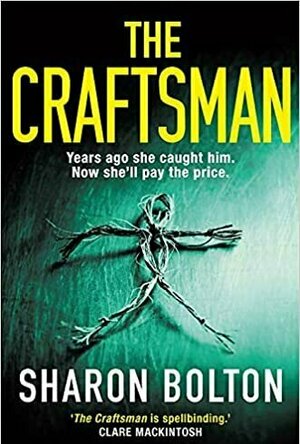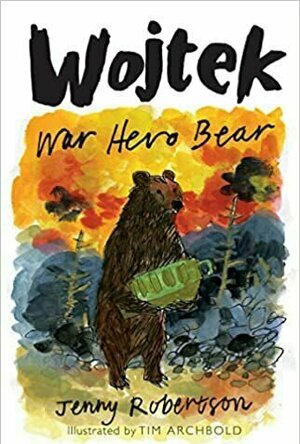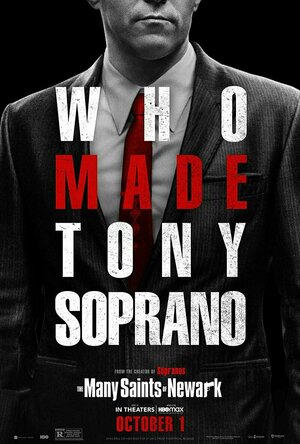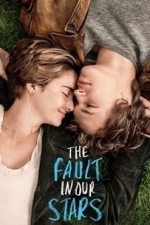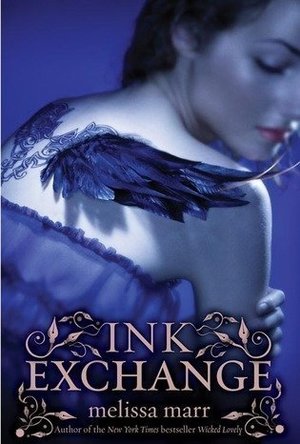Search
BookInspector (124 KP) rated The Craftsman (The Craftsman, #1) in Books
Sep 24, 2020
My Queen of crime and thrillers is back, with another marvelous story to tell. I read all her books, and every time she surprises me with something different and original.
The story is set in a small town with a hill, where witches were meeting since the 16th century. As you can see in the description above, this story is told in two different times – 1969 and 1999. In 1969 Florence was a WPC in the local police station, which she recently joined. Moreover, she was the first woman in that station, surrounded by men, who are not very friendly. She is assigned a disappearance of three teenagers, but what she discovers is way more complex and sinister than she could imagine.
Florence is the protagonist of this novel, and this story is told from her perspective. I love strong, smart and rebellious female leads in the books, and I absolutely loved Florence. Even though she is facing cruel workplace bullying and constant demeaning behavior, she is still fighting for what she believes to be right, and she wipes noses to those stuck up men. BRAVO! 😀 I really liked the wide variety of characters, which Bolton offered in this novel. All of them were very well rounded and unique personalities, who brought more richness to the book.
The narrative of this book was very well planned out and delivered. I was sucked in from the first pages of this book, I just wanted to find out what in a world was going on there! I really enjoyed all the twists, turns and diversions which Bolton creatively incorporated in this book. Sharon Bolton always follows an intriguing topic in her novels, and I am very glad that she was discussing workplace bullying and sexism, alongside witches and witchcraft. Even though I am not a believer in witchcraft, It was amusing to read about the people who believe in it and practice it.
Sharon Bolton is a very talented storyteller, she has a very absorbing and suspense building writing style, which I thoroughly enjoy every time. I loved the setting of this book, it compliments the atmosphere of this book with all those mills, hills, cemeteries and complex houses. The pages just fly while reading those short chapters. The climax was absolutely unexpected and left me very surprised. So, to conclude, for now, this book was the best read of 2018 for me. I enjoyed it from first to the last page, I think it has very intriguing and absorbing characters and very well crafted narrative, which is fast paced and very amusing. I do strongly recommend this book, I think you are in for a treat. Enjoy! 🙂
The story is set in a small town with a hill, where witches were meeting since the 16th century. As you can see in the description above, this story is told in two different times – 1969 and 1999. In 1969 Florence was a WPC in the local police station, which she recently joined. Moreover, she was the first woman in that station, surrounded by men, who are not very friendly. She is assigned a disappearance of three teenagers, but what she discovers is way more complex and sinister than she could imagine.
Florence is the protagonist of this novel, and this story is told from her perspective. I love strong, smart and rebellious female leads in the books, and I absolutely loved Florence. Even though she is facing cruel workplace bullying and constant demeaning behavior, she is still fighting for what she believes to be right, and she wipes noses to those stuck up men. BRAVO! 😀 I really liked the wide variety of characters, which Bolton offered in this novel. All of them were very well rounded and unique personalities, who brought more richness to the book.
The narrative of this book was very well planned out and delivered. I was sucked in from the first pages of this book, I just wanted to find out what in a world was going on there! I really enjoyed all the twists, turns and diversions which Bolton creatively incorporated in this book. Sharon Bolton always follows an intriguing topic in her novels, and I am very glad that she was discussing workplace bullying and sexism, alongside witches and witchcraft. Even though I am not a believer in witchcraft, It was amusing to read about the people who believe in it and practice it.
Sharon Bolton is a very talented storyteller, she has a very absorbing and suspense building writing style, which I thoroughly enjoy every time. I loved the setting of this book, it compliments the atmosphere of this book with all those mills, hills, cemeteries and complex houses. The pages just fly while reading those short chapters. The climax was absolutely unexpected and left me very surprised. So, to conclude, for now, this book was the best read of 2018 for me. I enjoyed it from first to the last page, I think it has very intriguing and absorbing characters and very well crafted narrative, which is fast paced and very amusing. I do strongly recommend this book, I think you are in for a treat. Enjoy! 🙂
BookInspector (124 KP) rated Wojtek: War Hero Bear in Books
Sep 24, 2020
More reviews at https://bbookinspector.wordpress.com
Well, I think this book is classified as a children’s read, but I noticed, that you should have pretty good knowledge in history, in order to understand what is going on in here. I picked up this book after reading a Holocaust memoir, so it was a very nice continuation to my reading theme. 😀
When Piotr, a polish soldier, discovers an abandoned bear cub, he decides to take him along on his journey to Palestine. But he discovers, that after losing his family to the Soviet regimen, Piotr feels very lonely, and Wojtek’s presence comforts not only him but other soldiers as well. I really liked the characters in this book, I found them charming, warm and pleasant personalities. I really enjoyed that author used multiple perspectives in this novel, I really loved reading Wojtek’s parts, I found them cute and funny. I loved the parts, were author shared Piotr’s story with the readers. It is a very sad story involving concentration camps and betrayal, but these parts made the whole book more complex and more interesting for me. (as an adult with some knowledge of history…)
The narrative follows the army squad accompanied by Wojtek, through their journeys in the middle east, and is very fun to read. I have to agree, Wojtek is a very funny and smart bear, and I loved all his mishaps. The author has done a great research for this novel, however, sometimes it felt like reading a history book, filled with war terminology and facts. Another aspect I really enjoyed was the pictures, Tim Archbold did a great job on them. I am glad that every chapter had a picture, and I was curious to find out, which scene from that chapter he decided to illustrate. 🙂
The writing style of this book was pretty straightforward, and it was quite easy and enjoyable for me. The chapters were a decent length and the pictures helped to make it more entertaining and playful. I did enjoy the setting of this book, it changes continuously, bringing in different scenery and atmosphere. I think that the ending was very realistic and believable for this novel, but some aspects left me a little bit upset with Piotr. So, to conclude, It is a great read for children as well as adults, especially if your child is learning about WWII, I think it would widen up their knowledge and you would have great fun reading it as well. Win-win situation. 😀 This novel has amusing characters as well as lots of serious and fun moments, and I do recommend to give this book a try. Enjoy 🙂
Well, I think this book is classified as a children’s read, but I noticed, that you should have pretty good knowledge in history, in order to understand what is going on in here. I picked up this book after reading a Holocaust memoir, so it was a very nice continuation to my reading theme. 😀
When Piotr, a polish soldier, discovers an abandoned bear cub, he decides to take him along on his journey to Palestine. But he discovers, that after losing his family to the Soviet regimen, Piotr feels very lonely, and Wojtek’s presence comforts not only him but other soldiers as well. I really liked the characters in this book, I found them charming, warm and pleasant personalities. I really enjoyed that author used multiple perspectives in this novel, I really loved reading Wojtek’s parts, I found them cute and funny. I loved the parts, were author shared Piotr’s story with the readers. It is a very sad story involving concentration camps and betrayal, but these parts made the whole book more complex and more interesting for me. (as an adult with some knowledge of history…)
The narrative follows the army squad accompanied by Wojtek, through their journeys in the middle east, and is very fun to read. I have to agree, Wojtek is a very funny and smart bear, and I loved all his mishaps. The author has done a great research for this novel, however, sometimes it felt like reading a history book, filled with war terminology and facts. Another aspect I really enjoyed was the pictures, Tim Archbold did a great job on them. I am glad that every chapter had a picture, and I was curious to find out, which scene from that chapter he decided to illustrate. 🙂
The writing style of this book was pretty straightforward, and it was quite easy and enjoyable for me. The chapters were a decent length and the pictures helped to make it more entertaining and playful. I did enjoy the setting of this book, it changes continuously, bringing in different scenery and atmosphere. I think that the ending was very realistic and believable for this novel, but some aspects left me a little bit upset with Piotr. So, to conclude, It is a great read for children as well as adults, especially if your child is learning about WWII, I think it would widen up their knowledge and you would have great fun reading it as well. Win-win situation. 😀 This novel has amusing characters as well as lots of serious and fun moments, and I do recommend to give this book a try. Enjoy 🙂

iBlacklist - Contacts manager all in one
Lifestyle and Utilities
App
◉ All-in-One Contact group management is the basic function. Contacts backup, Powerful batch...
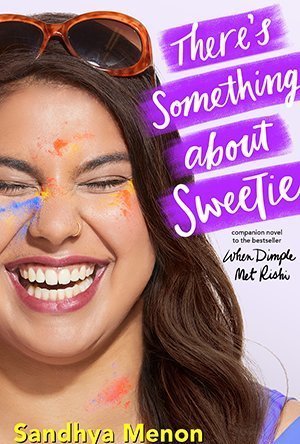
There's Something About Sweetie
Book
The irresistible companion novel to the New York Times bestseller When Dimple Met Rishi, which...
Sarah (7800 KP) rated Airplane! (1980) in Movies
Dec 8, 2020
Surely you can't be serious?
Film #6 on the 100 Movies Bucket List: Airplane!
Airplane! is a well known comedy classic, but for me I’m ashamed to admit that aside from the infamous “Don’t call me Shirley” line, I could barely remember a thing about this film. Airplane! is undoubtedly the mother, and master, of all comedy spoof films. Written and directed by Jim Abrahams and David and Jerry Zucker, this focuses Ted Striker (Robert Hays) who despite his fear of flying boards a plane to win back his girlfriend Elaine (Julie Hagerty), only to wind up having to ensure the plane lands safely when the pilots get sick.
The plot is definitely basic, but what it lacks in proper story it more than makes up for in laughs. I’ve never seen a film so chock full of jokes and gags, and in such a wide variety too. This features everything from subtle(ish) background jokes to witty and smart dialogue and obvious physical humour, and aside for a few misses, the majority of these jokes land perfectly. There’s the crude and hilarious auto pilot scene, to the incredibly funny and smart lines like when stewardess Elaine asks Doctor Rumack (Leslie Nielsen) about the onboard illness, “A hospital? What is it?”, to which he replies “It’s a big building with patients”. There’s something incredibly simple about the humour in this film that works so well, and yet aside from those few misses, it never resorts to crudeness that becomes disgusting and overbearing like most modern comedies do. These gags paired with the spoofing and sending up of disaster movies (plus many other genres) is a winning formula that has been emulated many times over by the likes of The Naked Gun and Hot Shots films since this was released in 1980. Admittedly there are some jokes that nowadays would be considered unacceptable and would never see the light of day, but fortunately these are a small minority and don’t spoil the overall enjoyment of the film, even now 40 years later.
The cast excel too in pulling off the over the top cheesiness you’d expect from a parody, and this is no mean feat. Whilst Julie Hagerty and Robert Hays do well as the main characters, it’s the smaller supporting roles that really stand out especially as they appear to have been given the best lines. You have Leslie Nielsen as the deadpan Doctor Rumack who delivers some hilarious dialogue with such a straight face, Lloyd Bridges as Steve McCroskey with his immortal lines beginning with “Looks like I picked the wrong week to stop…” and my absolute favourite background character Johnny (Stephen Stucker) who has some of the funniest moments you’ll ever see from such a minor character. And a notable mention has to go to Otto the automatic pilot, who even gets a feature in the credits.
Airplane! is a rightful comedy classic that could beat modern comedy films hands down, and it truly is a shame they don’t make spoofs like this anymore. It’s hilariously funny, right until the very end of the credits and an entirely unforgettable comedy experience.
Airplane! is a well known comedy classic, but for me I’m ashamed to admit that aside from the infamous “Don’t call me Shirley” line, I could barely remember a thing about this film. Airplane! is undoubtedly the mother, and master, of all comedy spoof films. Written and directed by Jim Abrahams and David and Jerry Zucker, this focuses Ted Striker (Robert Hays) who despite his fear of flying boards a plane to win back his girlfriend Elaine (Julie Hagerty), only to wind up having to ensure the plane lands safely when the pilots get sick.
The plot is definitely basic, but what it lacks in proper story it more than makes up for in laughs. I’ve never seen a film so chock full of jokes and gags, and in such a wide variety too. This features everything from subtle(ish) background jokes to witty and smart dialogue and obvious physical humour, and aside for a few misses, the majority of these jokes land perfectly. There’s the crude and hilarious auto pilot scene, to the incredibly funny and smart lines like when stewardess Elaine asks Doctor Rumack (Leslie Nielsen) about the onboard illness, “A hospital? What is it?”, to which he replies “It’s a big building with patients”. There’s something incredibly simple about the humour in this film that works so well, and yet aside from those few misses, it never resorts to crudeness that becomes disgusting and overbearing like most modern comedies do. These gags paired with the spoofing and sending up of disaster movies (plus many other genres) is a winning formula that has been emulated many times over by the likes of The Naked Gun and Hot Shots films since this was released in 1980. Admittedly there are some jokes that nowadays would be considered unacceptable and would never see the light of day, but fortunately these are a small minority and don’t spoil the overall enjoyment of the film, even now 40 years later.
The cast excel too in pulling off the over the top cheesiness you’d expect from a parody, and this is no mean feat. Whilst Julie Hagerty and Robert Hays do well as the main characters, it’s the smaller supporting roles that really stand out especially as they appear to have been given the best lines. You have Leslie Nielsen as the deadpan Doctor Rumack who delivers some hilarious dialogue with such a straight face, Lloyd Bridges as Steve McCroskey with his immortal lines beginning with “Looks like I picked the wrong week to stop…” and my absolute favourite background character Johnny (Stephen Stucker) who has some of the funniest moments you’ll ever see from such a minor character. And a notable mention has to go to Otto the automatic pilot, who even gets a feature in the credits.
Airplane! is a rightful comedy classic that could beat modern comedy films hands down, and it truly is a shame they don’t make spoofs like this anymore. It’s hilariously funny, right until the very end of the credits and an entirely unforgettable comedy experience.

Write - Notes & Writing
Productivity and Business
App
Write is an ultimate note taking & writing app. It combines simplicity with powerful features,...
BankofMarquis (1832 KP) rated The Many Saints of Newark (2021) in Movies
Oct 12, 2021
The "non-Sopranos" part of this film worked much better
The new Sopranos prequel film THE MANY SAINTS OF NEWARK is a review-proof film. Most people fall into 1 of 2 camps.
The first, fans of the 1999-2007 landmark HBO series that some (including myself) call one of the best TV series of all time. The folks that fall into this camp will be checking this film out no matter what.
The second are folks that either never saw the series or have only a passing knowledge of it - these folks are (more than likely) gonna take a pass at this film.
And both camps would be right and wrong for THE MANY SAINTS OF NEWARK is a middle-of-the-road film that will be satisfying for SOPRANOS fans, but the part of this film that really, really works well has nothing to do with the series.
Written by Sopranos creator David Chase, TMSON is set in the late 1960’s-early 1970’s and tells the tale of a young Tony Soprano and his introduction to the North Jersey mafia and the charismatic mob boss who he is drawn to.
The first 15 minutes of this film were written specifically for SOPRANOS fans for it is here that you are introduced to younger versions of many of your favorite characters. From Tony to Uncle Junior to Livia (Tony’s Mom) to Pauly Walnuts, Silvio and “Big Pussy” they are all there - along with a few others you don’t know (and it is not a spoiler to say, there is a reason that they never made it to the TV series). You are also introduced to Tony’s Father Johnny Soprano, Mob Boss “Hollywood” Dick Moltisanti and the center of this film, the son of the Boss “Uncle” Dickie Moltisanti (father of future TV Series character Christopher).
It’s an enjoyable enough introduction, but it is nothing new. The characters sit around, talk, act tough and eat. Something that we’ve seen in countless mob movies before. Chase and Director Alan Taylor (THOR: THE DARK WORLD) appear somewhat bored with this part of the film - almost as if they are saying “here they all are, enjoy this for we have a more interesting story to tell”. This first 15 minutes of the film seem to go on forever.
And then the movie - and Chase’s ideas and Taylor’s Direction - kick in.
And this is where TMSON begins to escalate as the story splits into 2 parts - the first following Dickie (Alessandro Nivola) and the 2nd following one of his “runners” (Leslie Odom, Jr.) who is destined to become a powerful boss of the “Black Mafia”.
It’s a smart juxtaposition of story, but unfortunately for SOPRANO’s fans, the first story (following Dickie) and including most of the Soprano’s characters is the less interesting of the 2 stories. It is the journey of Leslie Odom, Jr.’s character that makes for a more compelling story. It is as if Chase had an interesting idea for a mob film but knew he would not be able to get it made unless he tied it somewhat to a Sopranos story.
Leslie Odom Jr. is magnetic as Harold McBrayer, the former numbers runner for Dickie that has an awaking through the Black Power movement of the late ‘60’s and becomes a formidable mob boss in his own right. This half of the movie/story is intriguing and interesting for you never know in what direction it is going to land. This “B” story is free to be whatever it wants/needs to be and this freedom elevates it.
The same cannot be said for the “A” story - the journey of Dickie Moltisanti. Alessandro Nivola is charming enough as this sadistic, sociopathic mobster, but he is saddled with too much TV show baggage to become a character on his own. Specifically his mentorship and (ultimate) disassociation with the young Tony Soprano (played by Michael Gandolfini, the son of the late James Gandolfini who played Tony in the TV series). I felt like these characters were burdened with the weight of the TV show and the need to pay homage to what will be coming in their lives via the TV show and to shoehorn in each character along the way.
Consequently some great actors like Vera Farmiga (Tony’s mother Livia), Jon Bernthal (Tony’s father), and Corey Stoll (as Uncle Junior) are all filming extended cameos. They do a good (enough) job bringing the essence of the characters from the TV Series to this film, but they just don’t have enough to do. I would love for these 3 to spin-off on their own.
The same can be said for Billy Magnussen (Pauly), John Magaro (Silvio) and Samson Moeakiola (Big Pussy). They all do a nice job bringing the younger versions of these characters to life (especailly Magaro) but they just don’t have enough to do.
And then there is Ray Liotta’s over-the-top performance as Mob Boss “Hollywood” Dick Moltisanti. Ove-the-top doesn’t even begin to describe the performance he is giving. I will give him credit, though, he does tone it down about 1/2 way through the film, but…geez…the first part…wow.
Ultimately, the failure of the “A” story to captivate dooms this movie to mediocre status. I would have loved for Chase to really sink his teeth into the “B” story - and to let Leslie Odom Jr. really fly as a character and and actor.
But that would have defeated the purpose of making a Sopranos prequel - a prequel that, perhaps, shouldn’t have been made in the first place.
Letter Grade: B
7 stars (out of 10) and you can take that to the Bank(ofMarquis)
The first, fans of the 1999-2007 landmark HBO series that some (including myself) call one of the best TV series of all time. The folks that fall into this camp will be checking this film out no matter what.
The second are folks that either never saw the series or have only a passing knowledge of it - these folks are (more than likely) gonna take a pass at this film.
And both camps would be right and wrong for THE MANY SAINTS OF NEWARK is a middle-of-the-road film that will be satisfying for SOPRANOS fans, but the part of this film that really, really works well has nothing to do with the series.
Written by Sopranos creator David Chase, TMSON is set in the late 1960’s-early 1970’s and tells the tale of a young Tony Soprano and his introduction to the North Jersey mafia and the charismatic mob boss who he is drawn to.
The first 15 minutes of this film were written specifically for SOPRANOS fans for it is here that you are introduced to younger versions of many of your favorite characters. From Tony to Uncle Junior to Livia (Tony’s Mom) to Pauly Walnuts, Silvio and “Big Pussy” they are all there - along with a few others you don’t know (and it is not a spoiler to say, there is a reason that they never made it to the TV series). You are also introduced to Tony’s Father Johnny Soprano, Mob Boss “Hollywood” Dick Moltisanti and the center of this film, the son of the Boss “Uncle” Dickie Moltisanti (father of future TV Series character Christopher).
It’s an enjoyable enough introduction, but it is nothing new. The characters sit around, talk, act tough and eat. Something that we’ve seen in countless mob movies before. Chase and Director Alan Taylor (THOR: THE DARK WORLD) appear somewhat bored with this part of the film - almost as if they are saying “here they all are, enjoy this for we have a more interesting story to tell”. This first 15 minutes of the film seem to go on forever.
And then the movie - and Chase’s ideas and Taylor’s Direction - kick in.
And this is where TMSON begins to escalate as the story splits into 2 parts - the first following Dickie (Alessandro Nivola) and the 2nd following one of his “runners” (Leslie Odom, Jr.) who is destined to become a powerful boss of the “Black Mafia”.
It’s a smart juxtaposition of story, but unfortunately for SOPRANO’s fans, the first story (following Dickie) and including most of the Soprano’s characters is the less interesting of the 2 stories. It is the journey of Leslie Odom, Jr.’s character that makes for a more compelling story. It is as if Chase had an interesting idea for a mob film but knew he would not be able to get it made unless he tied it somewhat to a Sopranos story.
Leslie Odom Jr. is magnetic as Harold McBrayer, the former numbers runner for Dickie that has an awaking through the Black Power movement of the late ‘60’s and becomes a formidable mob boss in his own right. This half of the movie/story is intriguing and interesting for you never know in what direction it is going to land. This “B” story is free to be whatever it wants/needs to be and this freedom elevates it.
The same cannot be said for the “A” story - the journey of Dickie Moltisanti. Alessandro Nivola is charming enough as this sadistic, sociopathic mobster, but he is saddled with too much TV show baggage to become a character on his own. Specifically his mentorship and (ultimate) disassociation with the young Tony Soprano (played by Michael Gandolfini, the son of the late James Gandolfini who played Tony in the TV series). I felt like these characters were burdened with the weight of the TV show and the need to pay homage to what will be coming in their lives via the TV show and to shoehorn in each character along the way.
Consequently some great actors like Vera Farmiga (Tony’s mother Livia), Jon Bernthal (Tony’s father), and Corey Stoll (as Uncle Junior) are all filming extended cameos. They do a good (enough) job bringing the essence of the characters from the TV Series to this film, but they just don’t have enough to do. I would love for these 3 to spin-off on their own.
The same can be said for Billy Magnussen (Pauly), John Magaro (Silvio) and Samson Moeakiola (Big Pussy). They all do a nice job bringing the younger versions of these characters to life (especailly Magaro) but they just don’t have enough to do.
And then there is Ray Liotta’s over-the-top performance as Mob Boss “Hollywood” Dick Moltisanti. Ove-the-top doesn’t even begin to describe the performance he is giving. I will give him credit, though, he does tone it down about 1/2 way through the film, but…geez…the first part…wow.
Ultimately, the failure of the “A” story to captivate dooms this movie to mediocre status. I would have loved for Chase to really sink his teeth into the “B” story - and to let Leslie Odom Jr. really fly as a character and and actor.
But that would have defeated the purpose of making a Sopranos prequel - a prequel that, perhaps, shouldn’t have been made in the first place.
Letter Grade: B
7 stars (out of 10) and you can take that to the Bank(ofMarquis)
5 Minute Movie Guy (379 KP) rated The Fault In Our Stars (2014) in Movies
Jun 26, 2019 (Updated Jun 26, 2019)
Undoubtedly one of the great love stories of our time. (3 more)
Shailene Woodley and Ansel Elgort are a perfect match.
John Green's novel is brilliantly adapted to the silver screen.
This is a movie that will stay with you long after it's over.
On the surface, it's easy to dismiss The Fault in Our Stars as being a sappy teenage love affair, but I can fortunately say that this is one of the great love stories of our time.
Based on John Green’s popular young adult novel, The Fault in Our Stars is a film that is profoundly beautiful, eloquent and heartfelt. It tells of an extraordinary love between two unforgettable characters who are brought together by similarly ill-fated circumstances. Hazel Grace Lancaster and Augustus Waters are both victims of cancer. Although they do their best to hide it, these two young adults are each afraid of their ominous and unstable futures. They’re just trying to live purposeful lives and experience life like normal teenagers, but the looming threat of an untimely death impedes that desire. However, for a film filled with so much uncertainty, I can fortunately say that there is little doubt that The Fault in Our Stars is one of the great love stories of our time.
On the surface, it’s easy to dismiss The Fault in Our Stars as being a sappy teenage love affair. I’ll confess that I went into the theater expecting to be fully surrounded by crying teenage girls, while I would be quietly laughing to myself at their heartache. What I surely didn’t anticipate, however, was to be so deeply drawn into the film. Even more surprising is the fact that The Fault in Our Stars has actually turned out to be my favorite movie of the year so far. This is a film that is sincerely heartfelt and unflinchingly genuine. It brings truth to the romantic fantasies we have, and teaches us that we can’t let the fear of possible heartache hold us back from the endless potential of love.
Make no mistake about it, The Fault in Our Stars is a tear-jerker. It’s difficult to watch these lovable characters endure such unjustifiable hardship. Hazel and Augustus are each forced to face a formidable fate that they shouldn’t have to. I really felt a strong attachment to both of them, and found them to be remarkably identifiable. This connection makes it all the more unsettling when their situations turn dire. The reason that The Fault in Our Stars manages to be so effective is because of its authenticity and accessibility. The characters are not only admirable, but relatable. They’re not simply reduced to being unfortunate young cancer patients that we’re meant to feel sorry for. While of course we can sympathize with their condition, it is their compassion and the content of their characters that make them so compelling.
While the film features its fair share of tragedy, I should make it clear that it’s not heart-wrenchingly malicious in the way it deals with its ensuing sadness. This is not a film that is deliberately trying to make anyone feel bad. It is merely being honest in its depiction of the unfairness that often exists in life. While you very well might cry when watching the film, it’s not entirely depressing and hopeless. In fact, I would argue that The Fault in Our Stars is more pleasant than painful. The sadness it makes you feel ends up all being worthwhile because of the joyous, unforgettable memories the movie creates along the way. This is a film that will stay with you long after seeing it. To answer the question you’re all wondering: no, the movie didn’t make me cry. Though my lack of tears is not a particularly good indicator of the emotional quality of the film. I don’t really allow myself to cry during movies, but I certainly came close, and it undeniably left me deeply touched and forever grateful that I watched it.
Being that this is a romance, I must warn you that this isn’t a movie for everyone. Truth be told, I’m a sucker for a good romance, but I’m aware not everyone has the patience for these kind of movies. The Fault in Our Stars is a slow-burning journey that takes its time to relish in the moments. It does this skillfully, maintaining a steady, balanced pace while building up to a powerful climax. Some may find the film to be a little too cutesy, but I think anyone who approaches it with an open-mind will find that it’s legitimately a really great film. My only real criticism of the movie involves the awkward return of a particular character towards the end of the movie. It makes for a rather unwelcome and perplexing intrusion, although it does at least help to set up the film’s wonderful ending.
John Green’s story is refreshing, witty, and modern. It is not only insightful in its depiction of love and life, but also offers an amazing attention to detail. It nails the feelings of love, and perfectly captures the life of being a teenager. The characters created by Green truly come to life in this film. Divergent star Shailene Woodley shines as Hazel, a young woman suffering from terminal thyroid cancer. Additionally, Ansel Elgort is incredibly charming as Augustus, a high school basketball star whose career ended short when cancer turned him into an amputee. The two of them are a perfect complementary match. Laura Dern also puts in a commendable performance as Hazel’s mom, a selfless, loving parent and companion. The film’s soundtrack is sensational. It’s appropriately fitting and delightful, featuring great work by artists such as Ed Sheeran, Birdy, and Ray LaMontagne. Every aspect of the movie comes together to produce a thoroughly poignant and relevant package.
The Fault in Our Stars is a film that speaks to our generation. It stares boldly into our fears of the eminent death that haunts us all, and makes no attempt to glamorize it. Even though it’s about a pair of teenagers, it’s not afraid to deal with mature content. It’s actually all the more engrossing and troubling because these two characters are young. They’re already facing a pivotal time in their lives and are learning to experience the world on their own accord, and yet their journeys are plagued by the callous complications of cancer. Their age gives the film a stronger emotional impact, emphasizing the preciousness of life and the importance of living it to the fullest. The Fault in Our Stars is a smart and stimulating movie, and just like its star characters, it is wholly worthy of remembrance.
(This review was originally posted at 5mmg.com on 7.12.14.)
On the surface, it’s easy to dismiss The Fault in Our Stars as being a sappy teenage love affair. I’ll confess that I went into the theater expecting to be fully surrounded by crying teenage girls, while I would be quietly laughing to myself at their heartache. What I surely didn’t anticipate, however, was to be so deeply drawn into the film. Even more surprising is the fact that The Fault in Our Stars has actually turned out to be my favorite movie of the year so far. This is a film that is sincerely heartfelt and unflinchingly genuine. It brings truth to the romantic fantasies we have, and teaches us that we can’t let the fear of possible heartache hold us back from the endless potential of love.
Make no mistake about it, The Fault in Our Stars is a tear-jerker. It’s difficult to watch these lovable characters endure such unjustifiable hardship. Hazel and Augustus are each forced to face a formidable fate that they shouldn’t have to. I really felt a strong attachment to both of them, and found them to be remarkably identifiable. This connection makes it all the more unsettling when their situations turn dire. The reason that The Fault in Our Stars manages to be so effective is because of its authenticity and accessibility. The characters are not only admirable, but relatable. They’re not simply reduced to being unfortunate young cancer patients that we’re meant to feel sorry for. While of course we can sympathize with their condition, it is their compassion and the content of their characters that make them so compelling.
While the film features its fair share of tragedy, I should make it clear that it’s not heart-wrenchingly malicious in the way it deals with its ensuing sadness. This is not a film that is deliberately trying to make anyone feel bad. It is merely being honest in its depiction of the unfairness that often exists in life. While you very well might cry when watching the film, it’s not entirely depressing and hopeless. In fact, I would argue that The Fault in Our Stars is more pleasant than painful. The sadness it makes you feel ends up all being worthwhile because of the joyous, unforgettable memories the movie creates along the way. This is a film that will stay with you long after seeing it. To answer the question you’re all wondering: no, the movie didn’t make me cry. Though my lack of tears is not a particularly good indicator of the emotional quality of the film. I don’t really allow myself to cry during movies, but I certainly came close, and it undeniably left me deeply touched and forever grateful that I watched it.
Being that this is a romance, I must warn you that this isn’t a movie for everyone. Truth be told, I’m a sucker for a good romance, but I’m aware not everyone has the patience for these kind of movies. The Fault in Our Stars is a slow-burning journey that takes its time to relish in the moments. It does this skillfully, maintaining a steady, balanced pace while building up to a powerful climax. Some may find the film to be a little too cutesy, but I think anyone who approaches it with an open-mind will find that it’s legitimately a really great film. My only real criticism of the movie involves the awkward return of a particular character towards the end of the movie. It makes for a rather unwelcome and perplexing intrusion, although it does at least help to set up the film’s wonderful ending.
John Green’s story is refreshing, witty, and modern. It is not only insightful in its depiction of love and life, but also offers an amazing attention to detail. It nails the feelings of love, and perfectly captures the life of being a teenager. The characters created by Green truly come to life in this film. Divergent star Shailene Woodley shines as Hazel, a young woman suffering from terminal thyroid cancer. Additionally, Ansel Elgort is incredibly charming as Augustus, a high school basketball star whose career ended short when cancer turned him into an amputee. The two of them are a perfect complementary match. Laura Dern also puts in a commendable performance as Hazel’s mom, a selfless, loving parent and companion. The film’s soundtrack is sensational. It’s appropriately fitting and delightful, featuring great work by artists such as Ed Sheeran, Birdy, and Ray LaMontagne. Every aspect of the movie comes together to produce a thoroughly poignant and relevant package.
The Fault in Our Stars is a film that speaks to our generation. It stares boldly into our fears of the eminent death that haunts us all, and makes no attempt to glamorize it. Even though it’s about a pair of teenagers, it’s not afraid to deal with mature content. It’s actually all the more engrossing and troubling because these two characters are young. They’re already facing a pivotal time in their lives and are learning to experience the world on their own accord, and yet their journeys are plagued by the callous complications of cancer. Their age gives the film a stronger emotional impact, emphasizing the preciousness of life and the importance of living it to the fullest. The Fault in Our Stars is a smart and stimulating movie, and just like its star characters, it is wholly worthy of remembrance.
(This review was originally posted at 5mmg.com on 7.12.14.)
Rachel King (13 KP) rated Ink Exchange (Wicked Lovely, #2) in Books
Feb 11, 2019
The second book in the Wicked Lovely series is decidely darker than the first book, especially as it focuses on the Dark Court. A major plot point is Leslie's struggles to deal with how her brother and father have fallen off the "deep end" and the rape that her brother allowed to happen to her. She believes a tattoo will allow her to reclaim her body as her own and stop being afraid, but the tattoo she chooses has unimaginable consequences as she becomes entangled into the drama of the faery courts that her best friend Aislinn belongs to.
I like the change in main characters, as we get to see this world through other characters' eyes as well as learn about different aspects that Keenan or Aislinn may not be familiar with. I had a difficult time finding a character to really love, as all three of the main characters, Leslie, Irial, and Niall, all seemed to have major faults that I had a hard time getting around. The theme for this book seemed to be the darker side of humanity and how deeply entrenched people can get into the "gray" area of life, while still believing that they are not doing anything wrong. Irial wants to only use Leslie, just as he has for every other mortal, but then he falls for her. Leslie wants to be her own person and hates her brother for his druggie lifestyle, but then becomes an addict just like Ren. Niall has shunned the Dark Court for all it stands for, even denying his own nature, but then wants Leslie so bad that he unknowingly uses what he is and what the Dark Court is about to try and lure her to him. In a word, they all behave like hypocrites, but Marr is such a good writer, that I find myself feeling sorry for all of them at some point. While in many fantasy genre works, the female lead often has to choose between two guys, Marr takes a completely unpredictable approach, and I think that I like this ending the best of all possibilities. Plus, since this is only the second book in a series, there is potential for Leslie to change her mind in the long run as she becomes more comfortable in her own skin.
The way that Marr approaches the horrific trauma that Leslie endured prior to this book's beginning is handled very delicately, as it should be. It is never really described in detail what exactly happens to her, and it is mostly left up to the reader's imagination, which I think is a smart move in that girls who have been in a situation similar to Leslie's can relate to her and feel like they have a voice in her words and thoughts. This alone is what makes this book both poignant and powerful. The fact that both males vying for her affection try to rescue her from this trauma in his own way is what redeems both of them for me.
Politics run heavy in this series, and while I am not really a fan of politics in real life, fantasy books often make it much more interesting, Marr's writing being no exception. The dynamics between the faery courts are quite intriguing and I think they seem to balance one another out well, even though at first glance it might seem like some should be kept over others. I find myself constantly wondering about the High Court and its Queen, Sorcha, which I can look forward to in the third installment in the series, Fragile Eternity (Wicked Lovely).
I like the change in main characters, as we get to see this world through other characters' eyes as well as learn about different aspects that Keenan or Aislinn may not be familiar with. I had a difficult time finding a character to really love, as all three of the main characters, Leslie, Irial, and Niall, all seemed to have major faults that I had a hard time getting around. The theme for this book seemed to be the darker side of humanity and how deeply entrenched people can get into the "gray" area of life, while still believing that they are not doing anything wrong. Irial wants to only use Leslie, just as he has for every other mortal, but then he falls for her. Leslie wants to be her own person and hates her brother for his druggie lifestyle, but then becomes an addict just like Ren. Niall has shunned the Dark Court for all it stands for, even denying his own nature, but then wants Leslie so bad that he unknowingly uses what he is and what the Dark Court is about to try and lure her to him. In a word, they all behave like hypocrites, but Marr is such a good writer, that I find myself feeling sorry for all of them at some point. While in many fantasy genre works, the female lead often has to choose between two guys, Marr takes a completely unpredictable approach, and I think that I like this ending the best of all possibilities. Plus, since this is only the second book in a series, there is potential for Leslie to change her mind in the long run as she becomes more comfortable in her own skin.
The way that Marr approaches the horrific trauma that Leslie endured prior to this book's beginning is handled very delicately, as it should be. It is never really described in detail what exactly happens to her, and it is mostly left up to the reader's imagination, which I think is a smart move in that girls who have been in a situation similar to Leslie's can relate to her and feel like they have a voice in her words and thoughts. This alone is what makes this book both poignant and powerful. The fact that both males vying for her affection try to rescue her from this trauma in his own way is what redeems both of them for me.
Politics run heavy in this series, and while I am not really a fan of politics in real life, fantasy books often make it much more interesting, Marr's writing being no exception. The dynamics between the faery courts are quite intriguing and I think they seem to balance one another out well, even though at first glance it might seem like some should be kept over others. I find myself constantly wondering about the High Court and its Queen, Sorcha, which I can look forward to in the third installment in the series, Fragile Eternity (Wicked Lovely).

Tongits Wars
Games
App
The most exciting rummy game ever! Manipulate your luck by doing strategic and decisive actions and...
